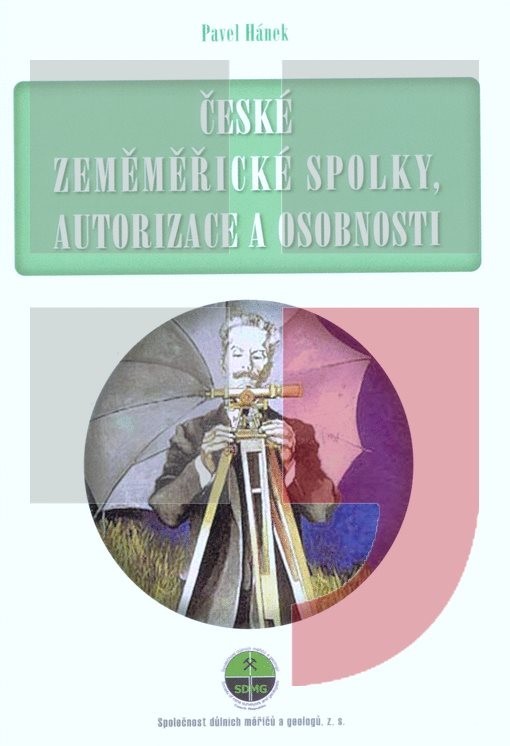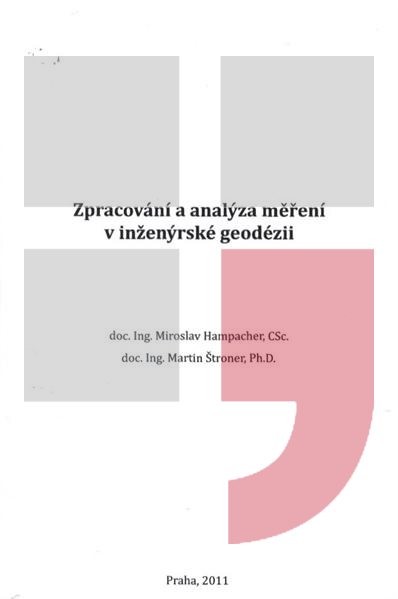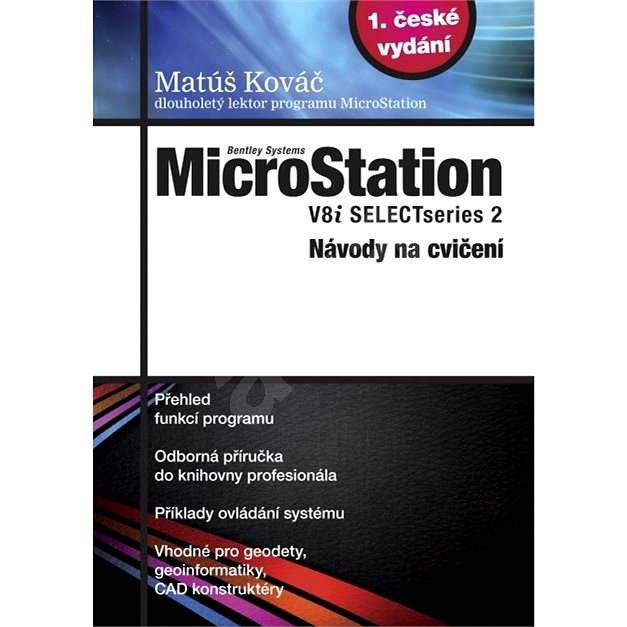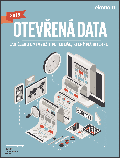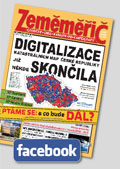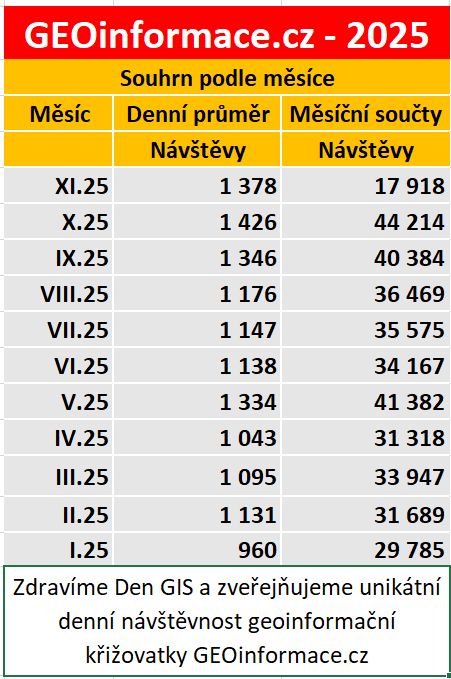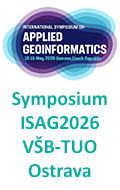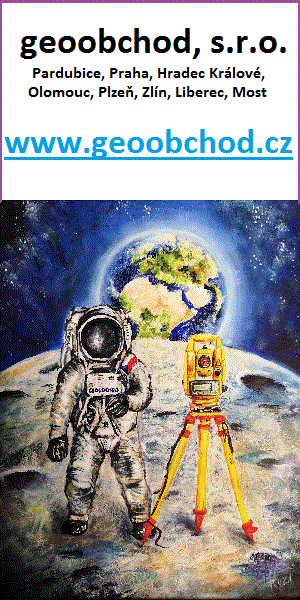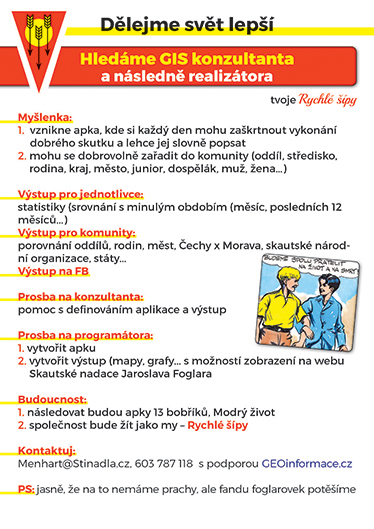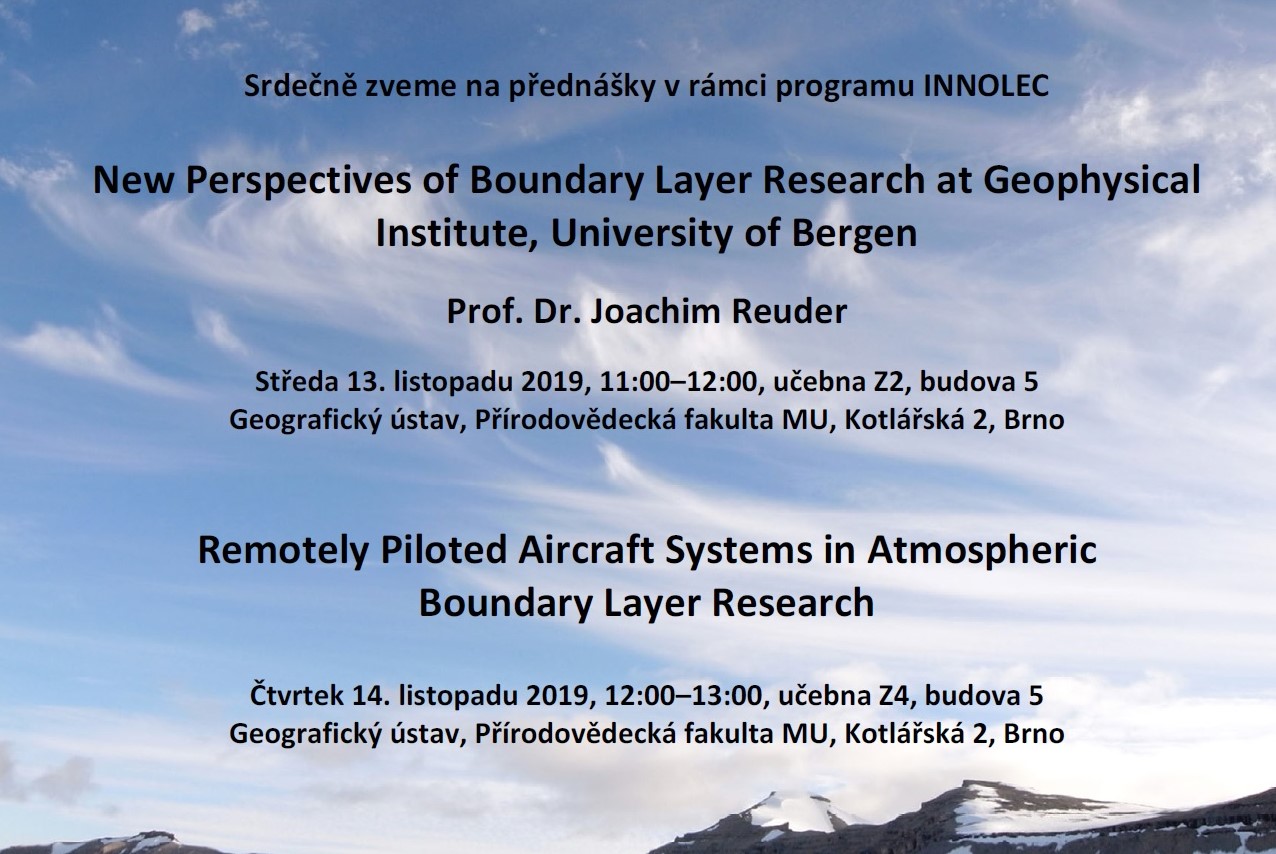zprávy
zdroje zpráv:Esri Joins Autodesk University 2019 Conference
14.11.2019 19:32 GISCafe.com Webcasts-Webinars GIS Experts Will Demonstrate How Location Intelligence Enables Smart Design and PlanningREDLANDS, Calif. — (BUSINESS WIRE) — November …
Texas A&M University to Establish Trimble Technology Lab for Geosciences
14.11.2019 19:32 GISCafe.com Webcasts-Webinars SUNNYVALE, Calif. and COLLEGE STATION, Texas, Nov. 14, 2019 — (PRNewswire) — Texas A&M University has received a gift from …Drone Aviation Announces Record Revenue and Profitability in Third Quarter 2019
14.11.2019 19:32 GISCafe.com Webcasts-Webinars Company Achieves Improved Sequential Quarterly Results Driven by Additional Product Sales and Services Revenue in Support of United States Border …ɸ-Sat-2 challenge
14.11.2019 16:22 ESA Observing the Earth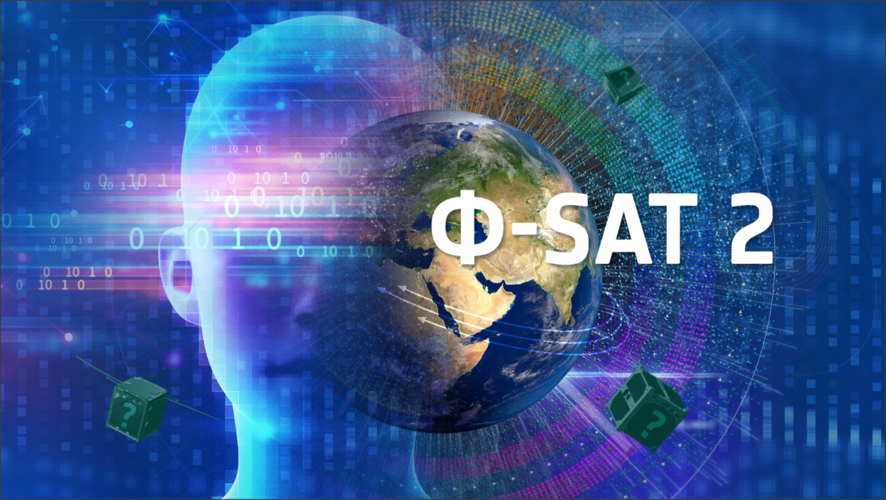
ɸ-Sat-2 challenge
Submit your idea for the AI ɸ-Sat-2 mission. Deadline 15 January 2020.
ɸ-Sat-2 challenge
14.11.2019 16:22 ESA Observing the Earth
ɸ-Sat-2 challenge
Submit your idea for the AI ɸ-Sat-2 mission. Deadline 15 January 2020.
Výstava 3D modelů [Katedra aplikované geoinformatiky a kartografie, byTopic]
14.11.2019 14:20 Katedra aplikované geoinformatiky a kartografie Přf UK Srdečně vás zveme na Výstavu 3D modelů, která probíhá od 11. listopadu do 29. února v předsálí Mapové sbírky na Albertově 6, Praha 2. Výstava prezentuje výsledky tvorby 3D modelů, které vznikly ve spolupráci vědeckých pracovníků a studentů na katedře aplikované geoinformatiky a kartografie PřF UK. Vstup volný.36. OGiC – Esri není black box s Ing. Petrem Seidlem, CSc. a Mgr. Ondřejem Sadílkem
14.11.2019 11:34 Katedra geoinformatiky UP OlomoucZnáte ArcGIS? 🌎 A umíte si představit, co se za ním skrývá? 🤓 Přijďte se dozvědět, co všechno ve světe GIS znamená Esri a čím se zabývá Arcdata Praha, s.r.o. 😊 27. listopadu od 10:00 na učebně S3 vám nejen o tom povykládá samotný řiditel této společnosti Ing. Petr Seidl, CSc. spolu s našim absolventem Mgr. Ondřejem Sadílkem 👌
The post 36. OGiC – Esri není black box s Ing. Petrem Seidlem, CSc. a Mgr. Ondřejem Sadílkem appeared first on Katedra geoinformatiky.
Plex.Earth Timeviews™ empowers AEC professionals with the latest satellite imagery within AutoCAD
14.11.2019 11:19 GISCafe.com Webcasts-Webinars November 14, 2019 -- Plexscape, developers of Plex.Earth®, one of the most popular tools for AutoCAD for the acceleration of …GNSS and the future of rail
14.11.2019 10:37 European GNSS Agency
New technologies that offer safety and efficiency benefits will define the rail system of the future. GNSS is one such technology and is already being used to track rolling-stock, and in passenger information, traffic management and predictive maintenance systems. In his speech at the ERTMS conference #CCRCC2019 “The Engine for the Digital Future,” European GNSS Agency (GSA) Executive Director Carlo des Dorides outlined how his Agency is working with the rail sector.
Over the last few years, the GSA has been working with its partners in the rail and space domains to introduce GNSS into non-safety relevant applications in the rail sector. This work has paid off, and currently more than 30 000 wagons of German rail freight company DB Cargo are equipped with Galileo-enabled telematics devices. Furthermore, 250 TGV trains in France are already using Galileo-enabled receivers and the rollout of these receivers on non-high speed trains is also in the pipeline.
A game changer
In his address at a conference, organised by the European Union Agency for Railways (ERA) in Valenciennes on October 15-17, the GSA Executive Director noted, however, that when it comes to the use of GNSS in signalling, progress had been slower. “We are simply not there yet and our main objective - to include European GNSS in the evolution of the ERTMS - is still being discussed,” he said.
To this end, the GSA defined a joint roadmap together with UNIFE, CER, Shift2Rail, the ERTMS Users Group and the European Space Agency (ESA) and, in 2016, GNSS entered the rail innovation landscape as an ERTMS game changer in a Memorandum of Understanding signed in 2016 to formalise an integrated management process for ERTMS deployment in Europe.
Read this: French railways embrace Galileo
Then, in 2017, together with ERA and International Union of Railways (UIC) the GSA participated in the first demonstration of an E-GNSS based virtual balise concept on board a running train on a pilot line in Sardinia, where work is continuing towards possible certification.
“We have also supported the EU railway industry in conducting a large-scale test campaign to define the achievable GNSS performance in the complex railway environment. Our partners in Shift2Rail are using these results to define the suitable architectures for GNSS inclusion in the ERTMS, hopefully within the next release planned for 2023,” des Dorides said.
Exporting innovation
GNSS is already being used in train positioning for safety relevant applications in the United States and a European manufacturer of GNSS chipsets has been selected to equip more than 30 000 miles of track with an augmentation system, improving GNSS performance in terms of accuracy and integrity. “Their receivers, which are Galileo enabled, will also be mounted on all new freight locomotives of the WABTEC Corporation. This is a clear success for a European company, benefitting from innovation and proving the European capacity to drive innovation,” des Dorides said.
Watch this: EGNOS and Galileo for Rail
Noting that GNSS is already supporting safety-relevant and liability-critical applications in other segments, such as aviation and road, des Dorides noted that in rail too, it was time to progress to the demonstration and certification of the technology “to make sure that Europe does not miss the train.”
“The GSA is committed to providing further support to rail stakeholders in this regard. We are ready to tailor our services, such as in case of EGNOS, based on the operational needs and requirements of railways, with properly defined interoperable interfaces,” he said, adding that this was an important element, as the introduction of GNSS into the ERTMS is not about creating space for any vendor-specific or national solutions.
“What we need is continuation of the commitment and collaboration from rail operators, infrastructure managers and the EU railway industry working with us to overcome the ‘last mile’ towards inclusion of interoperable GNSS-based positioning within the next evolutions of the ERTMS,” he said.
Media note: This feature can be republished without charge provided the European GNSS Agency (GSA) is acknowledged as the source at the top or the bottom of the story. You must request permission before you use any of the photographs on the site. If you republish, we would be grateful if you could link back to the GSA website (http://www.gsa.europa.eu).
Pozvánka na přednášku Ing. Petra Seidla, CSc. z firmy ARCDATA PRAHA, s.r.o.
14.11.2019 10:16 Blogující geomatici - FAV ZČU Dovolujeme si vás pozvat na přednášku Ing. Petra Seidla, CSc. ze společnosti ARCDATA PRAHA, s.r.o., který bude dne 25. 11. ve 13:00 v UC 233 hovořit o užitečnosti geografických informačních systémů pro společnost a o jejich různorodých způsobu nasazení a využití.Map of the Month: GfK Purchasing Power Europe 2019
14.11.2019 10:15 GISCafe.com Webcasts-Webinars GfK's Map of the Month for November shows the distribution of purchasing power in Europe in 2019.Bruchsal, 13.11.2019 -- According to …
Enterprise Partnerships with Trimble and Microsoft Drive senseFly Strategy Forward
14.11.2019 10:04 GISCafe.com Webcasts-Webinars CHESEAUX-SUR-LAUSANNE, Switzerland, 13 November 2019 – senseFly, the global leader in fixed-wing drones, has announced new strategic …Sanjay Gangal interviews Todd Stave, CEO from Blue Vigil at UAV CONFERENCE
14.11.2019 9:00 GISCafe.com Webcasts-WebinarsDJI Demonstrates Direct Drone-To-Phone Remote Identification
14.11.2019 1:45 GISCafe.com Webcasts-Webinars Simple, Low-Cost Solution Meets Government Expectations To Identify Airborne DronesMONTREAL, Nov. 13, 2019 — (PRNewswire) — DJI, the …
Území s dominantním výskytem tetřeva hlušce - fragmentační studie
14.11.2019 1:00 Cenia - Katalog metadat ČR - INSPIRE Polygonová vrstva území, které je dle studie fragmentační studie (zpracované Českou ornitologickou společností) územím, kde lze očekávat dominantní výskyt tetřeva hlušce (s určitými stanovenými hladinami pravděpodobnosti).Pravděpodobnosti výskytu - kateogie - nad 33,4%, nad 40%, nad 50%, nad 60% a nad 70%.Imise - pětileté průměry v síti 1 x 1 km
14.11.2019 1:00 Cenia - Katalog metadat ČR - INSPIRE Služba obsahuje pětileté průměry imisních koncentrací vybraných polutantů (PM10, PM2.5, NO2, benzen, arsen, Benzo(a)pyren, SO2, olovo, nikl, kadmium) v síti 1x1 km pro období 2014 - 2018, 2013 - 2017. Zdroj dat: Český hydrometeorologický ústav.Ortofotomapa NP a CHKO Šumava - 2019
14.11.2019 1:00 Cenia - Katalog metadat ČR - INSPIRE Ortofotomapa v přirozených barvách (R,G,B) i ortofomapa CIR.Pořizována v kladu mapových listů Státní mapy 1 : 5 000 (2 x 2,5 km).Pixel: 20 cmCarlson Introduces the New VS+ Stope Surveying System
13.11.2019 21:48 Carlson Software MAYSVILLE, Kentucky, U.S.A. (November 2019) — Carlson Software has just released its new Void Scanner+ (VS+), a fully wireless surveying system designed to be used for underground surveying. The system is an upgraded model of Carlson’s standard Void Scanner. Engineered to scan in extreme environments, the ruggedized VS+ system is designed to be deployed into […]Orbit GT and MaxOn Map, Brazil, sign Reseller Agreement
13.11.2019 20:26 GISCafe.com Webcasts-Webinars Lokeren, Belgium, November 8th, 2019 Orbit GT is pleased to announce that MaxOn Map Ltda, Brazil, has joined as Authorized Reseller of Orbit GT 3D …USGIF Accepting Applications for Annual Scholarship Program
13.11.2019 20:24 GISCafe.com Webcasts-Webinars Foundation offers a variety of scholarship opportunities for college studentsHerndon, Virginia (November 13, 2019)—The United States …
LeddarTech is Recognized as a CES 2020 Innovation Award Honoree for The Leddar Pixell, a Cocoon LiDAR Recently Released for the Autonomous Vehicle Market
13.11.2019 19:09 GISCafe.com Webcasts-Webinars QUEBEC CITY, Nov. 13, 2019 (GLOBE NEWSWIRE) -- LeddarTech®, an industry leader in LiDAR technology providing the most versatile and scalable …Velodyne Expert Addresses Lidar Use Cases to Improve Security and Safety Performance
13.11.2019 19:09 GISCafe.com Webcasts-Webinars Session Examines How Lidar Enables Smart Security and Automated Monitoring SystemsSAN JOSE, Calif. — (BUSINESS WIRE) — November 13, 2019 …
XAG Wins Top Honour the 'Best Innovation in Precision Farming Technology' at Crop Science Awards 2019
13.11.2019 19:09 GISCafe.com Webcasts-Webinars LONDON, Nov. 13, 2019 — (PRNewswire) — XAG has been awarded Best Innovation in Precision Farming Technology for its smart agriculture …ManTech Wins $82 Million NSWC Crane Award for Technical Innovation in Next Generation Unmanned ISR Aircraft
13.11.2019 19:09 GISCafe.com Webcasts-Webinars HERNDON, Va., Nov. 13, 2019 (GLOBE NEWSWIRE) -- ManTech (Nasdaq: MANT) announced today that it has been awarded a five-year $82 million prime task …DroneDeploy announces $35M Series D led by Bessemer Venture Partners
13.11.2019 19:09 GISCafe.com Webcasts-Webinars Tracy Young, founder of PlanGrid, joins Board to help bring DroneDeploy to every job siteSAN FRANCISCO, Nov. 13, 2019 — (PRNewswire) — …
Bushfires rage in Australia
13.11.2019 15:30 ESA Observing the Earth Image:
Image:
The Copernicus Sentinel-3 mission captured the multiple bushfires burning across Australia’s east coast. Around 150 fires are still burning in New South Wales and Queensland, with hot and dry conditions accompanied with strong winds, said to be spreading the fires.
In this image, captured on 12 November 2019 at 23:15 UTC (13 November 09:15 local time), the fires burning near the coast are visible. Plumes of smoke can be seen drifting east over the Tasman Sea. Hazardous air quality owing to the smoke haze has reached the cities of Sydney and Brisbane and is affecting residents, the Australian Environmental Department has warned.
Hundreds of homes have been damaged or destroyed, and many residents evacuated. Flame retardant was dropped in some of Sydney’s suburbs as bushfires approached the city centre. Firefighters continue to keep the blazes under control.
The Copernicus Emergency Mapping Service was activated to help respond to the fires. The service uses satellite observations to help civil protection authorities and, in cases of disaster, the international humanitarian community, respond to emergencies.
Quantifying and monitoring fires is fundamental for the ongoing study of climate, as they have a significant impact on global atmospheric emissions. Data from the Copernicus Sentinel-3 World Fire Atlas shows that there were almost five times as many wildfires in August 2019 compared to August 2018.
Bushfires rage in Australia
13.11.2019 15:30 ESA Observing the Earth Image:
Image:
The Copernicus Sentinel-3 mission captured the multiple bushfires burning across Australia’s east coast. Around 150 fires are still burning in New South Wales and Queensland, with hot and dry conditions accompanied with strong winds, said to be spreading the fires.
In this image, captured on 12 November 2019 at 23:15 UTC (13 November 09:15 local time), the fires burning near the coast are visible. Plumes of smoke can be seen drifting east over the Tasman Sea. Hazardous air quality owing to the smoke haze has reached the cities of Sydney and Brisbane and is affecting residents, the Australian Environmental Department has warned.
Hundreds of homes have been damaged or destroyed, and many residents evacuated. Flame retardant was dropped in some of Sydney’s suburbs as bushfires approached the city centre. Firefighters continue to keep the blazes under control.
The Copernicus Emergency Mapping Service was activated to help respond to the fires. The service uses satellite observations to help civil protection authorities and, in cases of disaster, the international humanitarian community, respond to emergencies.
Quantifying and monitoring fires is fundamental for the ongoing study of climate, as they have a significant impact on global atmospheric emissions. Data from the Copernicus Sentinel-3 World Fire Atlas shows that there were almost five times as many wildfires in August 2019 compared to August 2018.
Bushfires rage in Australia
13.11.2019 15:30 ESA Observing the Earth Image:
Image:
The Copernicus Sentinel-3 mission captured the multiple bushfires burning across Australia’s east coast. Around 150 fires are still burning in New South Wales and Queensland, with hot and dry conditions accompanied with strong winds, said to be spreading the fires.
In this image captured on 12 November 2019 at 23:15 UTC (13 November 09:15 local time), the fires burning near the coast are visible. Plumes of smoke can be seen drifting east over the Tasman Sea. Hazardous air quality owing to the smoke haze has reached the cities of Sydney and Brisbane and is affecting residents, the Australian Environmental Department has warned.
Hundreds of homes have been damaged or destroyed, and many residents evacuated. Flame retardant was dropped in some of Sydney’s suburbs as bushfires approached the city centre. Firefighters continue to keep the blazes under control.
The Copernicus Emergency Mapping Service was activated to help respond to the fires. The service uses satellite observations to help civil protection authorities and, in cases of disaster, the international humanitarian community, respond to emergencies.
Quantifying and monitoring fires is fundamental for the ongoing study of climate, as they have a significant impact on global atmospheric emissions. Data from the Copernicus Sentinel-3 World Fire Atlas shows that there were almost five times as many wildfires in August 2019 compared to August 2018.
Výstava "Joachim Barrande: To jest to, co jsem viděl" v Knihovně geologie [Knihovna geografie, byTopic]
13.11.2019 12:25 Katedra aplikované geoinformatiky a kartografie Přf UKEuropean Space Week: A taste of what to expect
13.11.2019 11:14 European GNSS Agency
It’s that time of year again. Preparations are already well underway for European Space Week 2019, which this year will take place at the Helsinki Congress Paasitorni in the Finnish capital on December 3-5. The week will be packed full of exciting events ranging from keynotes, discussions and conference sessions, to the E-GNSS User Assembly, a festive awards ceremony and much more.
As in previous years, European Space Week will address space-related topics targeted at various audiences, from policy-makers and start-ups to public authorities and industry players. With its mix of panel discussions, networking opportunities, business matchmaking sessions and exhibitions, EUSW is an ideal forum for a productive exchange of ideas and discussion of current challenges and future trends in the space sector.
This year’s European Space Week will focus on a number of central themes around sustainability. Participants will investigate how space solutions can help to strengthen the EU’s position as a global leader in climate action. Other themes include the new space economy for sustainable growth; the sustainable space economy - saving space for future generations; and space solutions for a sustainable Arctic. For a full programme of the week’s events, click here.
Read this: Galileo and EGNOS featured at InterGEO 2019
As always, European GNSS (Galileo and EGNOS) will be at the heart of events during Space Week, with an E-GNSS Service Provision Workshop, the E-GNSS User Assembly and a session at which Investors meet Innovators.
E-GNSS in focus
By bringing together stakeholders from across the space ecosystem, European Space Week is an ideal forum to host the E-GNSS User Assembly, which gathers users of position, navigation and time solutions and the organizations involved in the management, service provision and security of Galileo and EGNOS.
At the User Assembly, the European GNSS Agency (GSA) will present an update on GNSS user needs and requirements along with the results of its User Satisfaction Survey. It will also present highlights from the latest GNSS Market Report 2019.
Moreover, keynote speakers representing each market segment and receiver manufacturers will be invited to share the latest trends and applications on consumer solutions, road, aviation, drones, maritime, emergency response, rail, agriculture, geomatics, critical infrastructure and spacecraft.
The E-GNSS Service Provision Workshop will bring together E-GNSS stakeholders, professional and commercial users and application developers to discuss the current status of the EU satellite navigation programmes, and their vision for a stronger EU presence in the satnav applications landscape. There will also be a discussion on the future of EGNSS and the second generation of the Galileo programme. The aim of this session is to ensure that Galileo and EGNOS continue to deliver high quality services, accessible to all in the most cost-efficient manner, and responding to current and future user needs.
And this: Europe’s economy is increasingly dependent on space - ITRE committee hears
Power of synergy
To fully leverage the benefits of the EU space programmes EGNOS, Galileo and Copernicus we need to take a comprehensive look at these programmes. This allows us to see that there are market segments and applications that profit from synergies between E-GNSS and Copernicus and even the GOVSATCOM programme.
The Investors meet Innovators session will give innovators the chance to learn about various private funding opportunities and best practises on how to access funding and sustain their business. At the session, they will be able to engage in intensive discussions with financial partners from various backgrounds such as business angels, venture capitalists, public investment funds, crowd-funding and acceleration programmes.
EUSW will also host an SME Fair, showcasing SMEs developing Galileo, EGNOS or Copernicus-based applications, products and services.
Don’t miss out
Register here to attend European Space Week - Europe’s no. 1 space event. Don’t miss this exciting opportunity to discover cutting-edge Galileo and Copernicus applications and meet award-winning entrepreneurs, start-ups and visionaries. During the week, you will also have the opportunity to expand your network and interact with the Earth observation and satellite navigation community and discuss the latest trends with decision-makers, innovators and industry leaders.
Media note: This feature can be republished without charge provided the European GNSS Agency (GSA) is acknowledged as the source at the top or the bottom of the story. You must request permission before you use any of the photographs on the site. If you republish, we would be grateful if you could link back to the GSA website (http://www.gsa.europa.eu).
20191113 - VŘ ředitel KP Mělník
13.11.2019 9:44 ČÚZK - předpisy a opatření Český úřad zeměměřický a katastrální zveřejnil novou aktualitu: Oznámení o vyhlášení výběrového řízení na obsazení služebního místa ředitele katastrálního pracoviště Mělník.20191113 - VŘ ředitel KP Mělník
13.11.2019 9:44 ČÚZK /Aktuality-resort/2019/20191113-VR-reditel-KP-MelnikOpenGeoLabs nabízí technickou podporu open source softwaru
13.11.2019 9:28 GeoBusiness Firma OpenGeoLabs spouští program technické podpory otevřeného GIS software jako je QGIS, GRASS GIS, GeoServer, PostGIS a Python pro prostorová data. Podpora zahrnuje běžnou ... PřečístOpenGeoLabs nabízí technickou podporu open source softwaru
13.11.2019 9:28 GeoBusiness Firma OpenGeoLabs spouští program technické podpory otevřeného GIS software jako je QGIS, GRASS GIS, GeoServer, PostGIS a Python pro prostorová data. Podpora zahrnuje běžnou uživatelskou podporu, doporučení pracovních postupů (import dat, nastavení, problémy se spuštěním…), monitoring nových verzí a doporučení aktualizace softwaru, migraci procesů a dat z jiných prostředí do otevřeného software (podle rozsahu a […]Spationomy – OpenAccess Springer kniha ke stažení
13.11.2019 9:03 GISportal.cz
V prestižním vydavatelství Springer právě vyšla kniha s názvem Spationomy (Spatial Exploration of Economic Data and Methods of Interdisciplinary Analytics), na jejímž vzniku se podíleli olomoučtí geoinformatici. Kniha je završením úspěšné spolupráce v rámci mezinárodního projektu Spationomy a její .pdf verze je veřejnosti dostupná v režimu open-access na webových stránkách vydavatelství.
The post Spationomy – OpenAccess Springer kniha ke stažení appeared first on GISportal.cz.
Sanjay Gangal interviews Robert Blank, Director of Strategy from SolSpec, Inc at UAV CONFERENCE
13.11.2019 9:00 GISCafe.com Webcasts-WebinarsCubeWerx releases new tools for geospatial analytics
13.11.2019 9:00 GISCafe.com Webcasts-Webinars Gatineau, QC, Canada, November 14, 2019 – CubeWerx, a leader in providing advanced geospatial web services for data providers announced the …GeoSocial Networking Forum 2019
13.11.2019 2:17 Satlab GeosolutionsIt has been quite a year of development, and we have been innovating our solutions for professionals in the geospatial industry. We would like to take this opportunity to invite you to be the first in the region to learn about our newly developed applications for smart industries solution: Indoor Positioning Intelligence, Machine Control and […]
The post GeoSocial Networking Forum 2019 appeared first on Satlab – Global Satellite Positioning Solutions.
GeoSocial Networking Forum 2019
13.11.2019 2:17 Satlab GeosolutionsIt has been quite a year of development, and we have been innovating our solutions for professionals in the geospatial industry. We would like to take this opportunity to invite you to be the first in the region to learn about our newly developed applications for smart industries solution: Indoor Positioning Intelligence, Machine Control and […]
The post GeoSocial Networking Forum 2019 appeared first on SatLab – Global Satellite Positioning Solutions.
Výzva k podání návrhu - Spytihněv
13.11.2019 0:00 Státní pozemkový úřad SPÚ vyhlašuje výzvu k podání návrhů na uzavření nájemní smlouvy - kú SpytihněvOGC Renews Memorandum Of Understanding With FrontierSI
12.11.2019 21:24 GISCafe.com Webcasts-Webinars OGC and FrontierSI continue to work together to reach out, innovate, and educate at national, regional, and international levels.The Open …
Letní školy katedry geoinformatiky
12.11.2019 19:27 Katedra geoinformatiky UP OlomoucOpět po roce vám katedra přináší možnost přihlásit se na některou z letních škol 🧐 Je libo podívat se do Mariboru, Ultrechtu, Trondheimu, nebo radši preferujete krásy Olomouce? 🙂 Není problém, vybere si každý 😉 Přijďte se informovat o podrobnostech 21. 11. 2019 o 12:45 na učebnu S3 ‼️
The post Letní školy katedry geoinformatiky appeared first on Katedra geoinformatiky.
Nokia joins Sendai City in world’s first test of private wireless connected drones for tsunami evacuation alerts
12.11.2019 18:59 GISCafe.com Webcasts-Webinars Press Release Nokia joins Sendai City in world’s first test of private wireless connected drones for tsunami evacuation alerts …Beyond Ventures leads US$3m investment in Mapxus - a promising start-up in the nascent indoor-mapping industry
12.11.2019 18:59 GISCafe.com Webcasts-Webinars "Mapxus possesses exactly the kind of skillsets that will help transform Hong Kong into a smart city"HONG KONG, Nov. 12, 2019 — (PRNewswire) …
CoreLogic Reports U.S. Overall Delinquency Rate Lowest for an August in at Least 20 Years but Five States Post Annual Gains
12.11.2019 18:58 GISCafe.com Webcasts-Webinars Iowa, Minnesota, Nebraska, Wisconsin and Rhode Island posted small annual gains in their overall delinquency rates in AugustThe nation's serious …
DRAGANFLY INC. APPOINTS MILITARY AND UAV/UVS VETERAN PATRICK IMBASCIANI AS CHIEF OPERATING OFFICER
12.11.2019 18:58 GISCafe.com Webcasts-Webinars Vancouver, British Columbia, Nov. 12, 2019 (GLOBE NEWSWIRE) -- Draganfly Inc. (CSE: DFLY) (“Draganfly” or the “Company”), an award-winning, …Iris Automation And Kansas DOT Successfully Complete Historic Beyond-Visual-Line-Of-Sight Drone Flight
12.11.2019 18:58 GISCafe.com Webcasts-Webinars FAA UAS Integration Pilot Program partners complete first true beyond-visual-line-of-sight (BVLOS) drone operation, powered by Iris Automation's …Headwall & geo-konzept Announce Hyperspectral Remote-Sensing Center in Europe
12.11.2019 18:58 GISCafe.com Webcasts-Webinars Hannover, Germany, Nov. 12, 2019 (GLOBE NEWSWIRE) -- Headwall BVBA, Belgium and geo-konzept of Germany announced at Agritechnica 2019 the …REIN's DroneInsurance.com and Measure Collaborate to Provide Commercial Drone Operators with Integrated Access to Drone Insurance
12.11.2019 18:58 GISCafe.com Webcasts-Webinars Drone teams using Measure's Ground Control app will now have integrated access to DroneInsurance.com's 24/7 ground and usage-based flight coverage …Commercial UAV Expo Americas 2019 Completes 5th Annual Event, Exceeds All Prior Records
12.11.2019 18:57 GISCafe.com Webcasts-Webinars 3,100+ commercial drone thought-leaders and professionals from around the world gather in Las Vegas for CUAV19, a 32% increase over 2018LAS VEGAS, …
BlackSky Secures $50M in Funding from Intelsat
12.11.2019 18:49 GISCafe.com Webcasts-Webinars Creates First Industry Relationship to Pair Earth Observation with Global Communications InfrastructureHERNDON, Va. — (BUSINESS WIRE) — …
Improving new Aeolus wind data for forecasts
12.11.2019 17:09 ESA Observing the Earth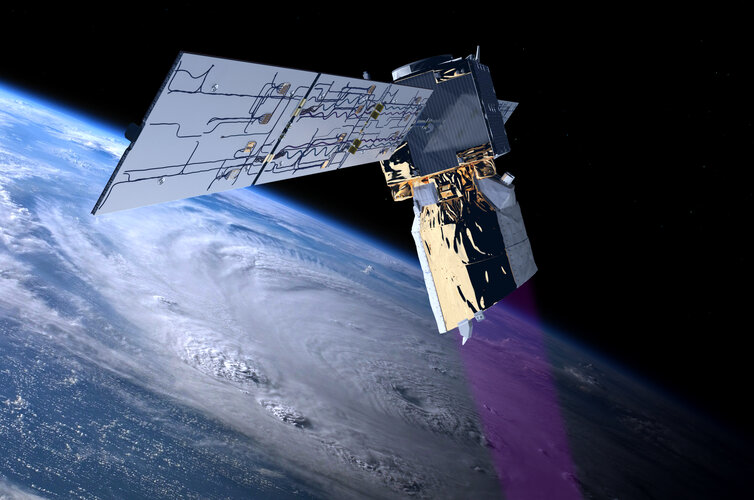
Tests carried out show that new wind profile observations from ESA’s Aeolus satellite significantly improve weather forecasts – particularly in the southern hemisphere and the tropics.
Improving new Aeolus wind data for forecasts
12.11.2019 17:09 ESA Observing the Earth
Tests carried out show that new wind profile observations from ESA’s Aeolus satellite significantly improves weather forecasts – particularly in the southern hemisphere and the tropics.
Referent/ka ZKN
12.11.2019 15:48 Zeměměřický úřad Zeměměřický úřadvypisuje výběrové řízení na místo
Referent/ka ZKN
Referent/ka ZKN
12.11.2019 15:48 ČÚZK - předpisy a opatření Zeměměřický úřadvypisuje výběrové řízení na místo
Referent/ka ZKN
Referent/ka ZKN
12.11.2019 15:48 ČÚZK - volná místa Zeměměřický úřad vypisuje výběrové řízení na místo Referent/ka ZKN20191112 rada/ odborný rada - právník v oddělení právních vztahů k nemovitostem
12.11.2019 14:52 ČÚZK /Urady/Katastralni-urady/Katastralni-urady/Katastralni-urad-pro-Stredocesky-kraj/Uredni-deska/Oznameni-a-jina-uredni-sdeleni/Volna-mista/20190828-Odborny-rada-oddeleni-pravnich-vztahu-(1)20191112 rada/ odborný rada - právník v oddělení právních vztahů k nemovitostem
12.11.2019 14:52 ČÚZK - předpisy a opatření Katastrální úřad pro Středočeský kraj - Katastrální pracoviště Mladá Boleslav Vyhlášení výběrového řízení: rada/ odborný rada - právník v oddělení právních vztahů k nemovitostem V části "Úřední deska", v sekci "Oznámení a jiná úřední sdělení" bylo vystaveno "Oznámení o vyhlášení výběrového řízení na obsazení systemizovaného místa rada/ odborný rada - právník v oddělení právních vztahů k nemovitostem"20191112 rada/ odborný rada - právník v oddělení právních vztahů k nemovitostem
12.11.2019 14:52 ČÚZK - předpisy a opatření Katastrální úřad pro Středočeský kraj - Katastrální pracoviště Mladá Boleslav Vyhlášení výběrového řízení: rada/ odborný rada - právník v oddělení právních vztahů k nemovitostem V části "Úřední deska", v sekci "Oznámení a jiná úřední sdělení" bylo vystaveno "Oznámení o vyhlášení výběrového řízení na obsazení služebního místa rada/ odborný rada - právník v oddělení právních vztahů k nemovitostem"20191112 rada/ odborný rada - právník v oddělení právních vztahů k nemovitostem
12.11.2019 14:50 ČÚZK /Urady/Katastralni-urady/Katastralni-urady/Katastralni-urad-pro-Stredocesky-kraj/Uredni-deska/Oznameni-a-jina-uredni-sdeleni/Volna-mista/20190828-Odborny-rada-oddeleni-pravnich-vztahu-(2)20191112 rada/ odborný rada - právník v oddělení právních vztahů k nemovitostem
12.11.2019 14:50 ČÚZK - předpisy a opatření Katastrální úřad pro Středočeský kraj - Katastrální pracoviště Mladá Boleslav Vyhlášení výběrového řízení: rada/ odborný rada - právník v oddělení právních vztahů k nemovitostem V části "Úřední deska", v sekci "Oznámení a jiná úřední sdělení" bylo vystaveno "Oznámení o vyhlášení výběrového řízení na obsazení služebního místa rada/ odborný rada - právník v oddělení právních vztahů k nemovitostem"20191112 rada/ odborný rada - právník v oddělení právních vztahů k nemovitostem
12.11.2019 14:43 ČÚZK - předpisy a opatření Katastrální úřad pro Středočeský kraj - Katastrální pracoviště Mladá Boleslav Vyhlášení výběrového řízení: rada/ odborný rada - právník v oddělení právních vztahů k nemovitostem V části "Úřední deska", v sekci "Oznámení a jiná úřední sdělení" bylo vystaveno "Oznámení o vyhlášení výběrového řízení na obsazení služebního místa rada/ odborný rada - právník v oddělení právních vztahů k nemovitostem"20191112 rada/ odborný rada - právník v oddělení právních vztahů k nemovitostem
12.11.2019 14:43 ČÚZK /Urady/Katastralni-urady/Katastralni-urady/Katastralni-urad-pro-Stredocesky-kraj/Katastralni-pracoviste/KP-Mlada-Boleslav/O-uradu/Aktuality/20190828-Odborny-rada-oddeleni-pravnich-vztahu-(2)rada/ odborný rada - právník v oddělení právních vztahů k nemovitostem
12.11.2019 14:41 ČÚZK - volná místa Katastrální úřad pro Středočeský kraj - Katastrální pracoviště Mladá Boleslav vypisuje výběrové řízení na místo rada/ odborný rada - právník v oddělení právních vztahů k nemovitostemrada/ odborný rada - právník v oddělení právních vztahů k nemovitostem
12.11.2019 14:41 ČÚZK - předpisy a opatření Katastrální úřad pro Středočeský kraj - Katastrální pracoviště Mladá Boleslavvypisuje výběrové řízení na místo rada/ odborný rada - právník v oddělení právních vztahů k nemovitostem
rada/ odborný rada - právník v oddělení právních vztahů k nemovitostem
rada/ odborný rada - právník v oddělení právních vztahů k nemovitostem
12.11.2019 14:41 ČÚZK /Urady/Katastralni-urady/Katastralni-urady/Katastralni-urad-pro-Stredocesky-kraj/Volna-mista/rada-odborny-rada-pravnik-v-oddeleni-pravnich-vKartograf
12.11.2019 12:01 Zeměměřický úřad Zeměměřický úřadvypisuje výběrové řízení na místo
Kartograf
Kartograf
12.11.2019 12:01 ČÚZK - předpisy a opatření Zeměměřický úřadvypisuje výběrové řízení na místo
Kartograf
Kartograf
12.11.2019 12:01 ČÚZK - volná místa Zeměměřický úřad vypisuje výběrové řízení na místo KartografKartograf
12.11.2019 12:01 ČÚZK /Urady/Zememericky-urad/Uredni-deska/Oznameni-a-jina-uredni-sdeleni/Volna-mista/KartografMovitý majetek monitory a multifunkční tiskárny
12.11.2019 11:32 ČÚZK - předpisy a opatřeníKatastrální úřad pro Pardubický kraj nabízí nepotřebný majetek k odkupu. Jedná se o
Movitý majetek monitory a multifunkční tiskárny
Movitý majetek monitory a multifunkční tiskárny
12.11.2019 11:32 ČÚZK /Urady/Katastralni-urady/Katastralni-urady/Katastralni-urad-pro-Pardubicky-kraj/Nabidky-majetku/Movity-majetek-monitory-a-multifunkcni-tiskarny20191112 Rada / odborný rada oddělení právních vztahů k nemovitostem
12.11.2019 11:16 ČÚZK - předpisy a opatření Katastrální úřad pro Středočeský kraj - Katastrální pracoviště Kladno Vyhlášení výběrového řízení: Rada / odborný rada oddělení právních vztahů k nemovitostem V části "Úřední deska", v sekci "Oznámení a jiná úřední sdělení" bylo vystaveno "Oznámení o vyhlášení výběrového řízení na obsazení služebního místa Rada / odborný rada oddělení právních vztahů k nemovitostem"20191112 Rada / odborný rada oddělení právních vztahů k nemovitostem
12.11.2019 11:16 ČÚZK /Urady/Katastralni-urady/Katastralni-urady/Katastralni-urad-pro-Stredocesky-kraj/Katastralni-pracoviste/KP-Kladno/O-uradu/Aktuality/20190828-Odborny-rada-oddeleni-pravnich-vztahu-(1)Rada / odborný rada oddělení právních vztahů k nemovitostem
12.11.2019 11:16 ČÚZK - předpisy a opatření Katastrální úřad pro Středočeský kraj - Katastrální pracoviště Kladnovypisuje výběrové řízení na místo Rada / odborný rada oddělení právních vztahů k nemovitostem
Rada / odborný rada oddělení právních vztahů k nemovitostem
Rada / odborný rada oddělení právních vztahů k nemovitostem
12.11.2019 11:16 ČÚZK - volná místa Katastrální úřad pro Středočeský kraj - Katastrální pracoviště Kladno vypisuje výběrové řízení na místo Rada / odborný rada oddělení právních vztahů k nemovitostemRada / odborný rada oddělení právních vztahů k nemovitostem
12.11.2019 11:16 ČÚZK /Urady/Katastralni-urady/Katastralni-urady/Katastralni-urad-pro-Stredocesky-kraj/Uredni-deska/Oznameni-a-jina-uredni-sdeleni/Volna-mista/Rada-odborny-rada-oddeleni-pravnich-vztahu-k-n-(3)Seminář o digitální technické mapě
12.11.2019 11:02 GeoBusiness Institut plánování a rozvoje hl. m. Prahy pořádá seminář o digitální technické mapě. Akce, určená odborné veřejnosti, nese název „DTM digitální technická mapa DNES A ZÍTRA“. Záštitu poskytla Česká asociace pro geoinformace. Datum: pondělí, 2. prosince 2019, CAMP (centrum architektury městského plánování), Vyšehradská 51, Praha 2, areál bývalého Emauzského kláštera http://praha.camp/ Program akce 9.30 10.00 […]Seminář o digitální technické mapě
12.11.2019 11:02 GeoBusiness Institut plánování a rozvoje hl. m. Prahy pořádá seminář o digitální technické mapě. Akce, určená odborné veřejnosti, nese název „DTM digitální technická mapa DNES ... PřečístVZ: Diagnostika vozovek v Jihočeském kraji
12.11.2019 10:35 ZeměměřičJihočeský kraj vypsal veřejnou zakázku s názvem „Diagnostický průzkum vozovek silnic II. a III. třídy v Jihočeském kraji“. Předmětem plnění v rámci tohoto zadávacího řízení je funkční a bezvadné provedení diagnostického průzkumu vozovek silnic II. a III. třídy v Jihočeském kraji v rozsahu specifikovaném touto zadávací dokumentací včetně příloh. Jedná se celkem o 78,678 km silnic. Zadavatel: Správa a údržba silnic Jihočeského kraje Datum zahájení […]
The post VZ: Diagnostika vozovek v Jihočeském kraji appeared first on Zeměměřič.
20191112 Rada / odborný rada oddělení právních vztahů k nemovitostem
12.11.2019 9:51 ČÚZK - předpisy a opatření Katastrální úřad pro Středočeský kraj - Katastrální pracoviště Benešov Vyhlášení výběrového řízení: Rada / odborný rada oddělení právních vztahů k nemovitostem Katastrálního pracoviště Benešov V části "Úřední deska", v sekci "Oznámení a jiná úřední sdělení" bylo vystaveno "Oznámení o vyhlášení výběrového řízení na obsazení služebního místa Rada / odborný rada oddělení právních vztahů k nemovitostem Katastrálního pracoviště Benešov"20191112 Rada / odborný rada oddělení právních vztahů k nemovitostem
12.11.2019 9:51 ČÚZK /Urady/Katastralni-urady/Katastralni-urady/Katastralni-urad-pro-Stredocesky-kraj/Katastralni-pracoviste/KP-Benesov/O-uradu/Aktuality/20190828-Odborny-rada-oddeleni-pravnich-vztahu-(2)Rada / odborný rada oddělení právních vztahů k nemovitostem
12.11.2019 9:49 ČÚZK - volná místa Katastrální úřad pro Středočeský kraj - Katastrální pracoviště Benešov vypisuje výběrové řízení na místo Rada / odborný rada oddělení právních vztahů k nemovitostemRada / odborný rada oddělení právních vztahů k nemovitostem
12.11.2019 9:49 ČÚZK - předpisy a opatření Katastrální úřad pro Středočeský kraj - Katastrální pracoviště Benešovvypisuje výběrové řízení na místo Rada / odborný rada oddělení právních vztahů k nemovitostem
Rada / odborný rada oddělení právních vztahů k nemovitostem
Rada / odborný rada oddělení právních vztahů k nemovitostem
12.11.2019 9:49 ČÚZK /Urady/Katastralni-urady/Katastralni-urady/Katastralni-urad-pro-Stredocesky-kraj/Uredni-deska/Oznameni-a-jina-uredni-sdeleni/Volna-mista/Rada-odborny-rada-oddeleni-pravnich-vztahu-k-n-(2)20191112 Ředitel odboru Katastrálního pracoviště Mělník – rada / odborný rada
12.11.2019 9:36 ČÚZK /Urady/Katastralni-urady/Katastralni-urady/Katastralni-urad-pro-Stredocesky-kraj/Katastralni-pracoviste/KP-Melnik/O-uradu/Aktuality/20190828-Odborny-rada-oddeleni-pravnich-vztahu-(1)20191112 Ředitel odboru Katastrálního pracoviště Mělník – rada / odborný rada
12.11.2019 9:36 ČÚZK - předpisy a opatření Katastrální úřad pro Středočeský kraj - Katastrální pracoviště Mělník Vyhlášení výběrového řízení: Ředitel odboru Katastrálního pracoviště Mělník – rada / odborný rada V části "Úřední deska", v sekci "Oznámení a jiná úřední sdělení" bylo vystaveno "Oznámení o vyhlášení výběrového řízení na obsazení služebního místa Ředitel odboru Katastrálního pracoviště Mělník – rada / odborný rada"Ředitel odboru Katastrálního pracoviště Mělník – rada / odborný rada
12.11.2019 9:34 ČÚZK /Urady/Katastralni-urady/Katastralni-urady/Katastralni-urad-pro-Stredocesky-kraj/Uredni-deska/Oznameni-a-jina-uredni-sdeleni/Volna-mista/Reditel-odboru-Katastralniho-pracoviste-Melnik-–-rŘeditel odboru Katastrálního pracoviště Mělník – rada / odborný rada
12.11.2019 9:34 ČÚZK - volná místa Katastrální úřad pro Středočeský kraj - Katastrální pracoviště Mělník vypisuje výběrové řízení na místo Ředitel odboru Katastrálního pracoviště Mělník – rada / odborný radaŘeditel odboru Katastrálního pracoviště Mělník – rada / odborný rada
12.11.2019 9:34 ČÚZK - předpisy a opatření Katastrální úřad pro Středočeský kraj - Katastrální pracoviště Mělníkvypisuje výběrové řízení na místo Ředitel odboru Katastrálního pracoviště Mělník – rada / odborný rada
Ředitel odboru Katastrálního pracoviště Mělník – rada / odborný rada
Sanjay Gangal interviews Michael Kelly , VP Sales from TerraView at UAV CONFERENCE
12.11.2019 9:00 GISCafe.com Webcasts-WebinarsINSPIRE prohlížecí služba WMS rozšířené katastrální parcely (CPX) - test
12.11.2019 1:00 Cenia - Katalog metadat ČR - INSPIRE Testovací metadata pro prohlížecí službu (WMS) pro rozšířené katastrální parcely (CPX). Služba splňuje technické pokyny pro INSPIRE prohlížecí služby v. 3.11 a zároveň splňuje standard OGC WMS 1.1.1. a 1.3.0.Karotážní data (geofyzika) - vrty
12.11.2019 1:00 Cenia - Katalog metadat ČR - INSPIRE Databáze obsahuje karotážní a inklinometrická měření a je postupně naplňována od roku 1999.Stacionární zdroje znečišťování - palivo, výkon
12.11.2019 1:00 Cenia - Katalog metadat ČR - INSPIRE Mapová služba prezentuje vyjmenované stacionární zdroje znečištění ovzduší (REZZO 1 a 2) dle jejich instalovaného tepelného výkonu a převládajícího druhu paliva. Vstupní data jsou každoročně aktualizována. Poslední aktualizace: listopad 2019. Stav dat: 2018.INSPIRE téma Rozšířené Parcely (CPX)
12.11.2019 1:00 Cenia - Katalog metadat ČR - INSPIRE Rozšíření má za cíl poskytovat katastrální mapu s obsahem podle vyhlášky ve vektorové podobě ve struktuře plně v souladu se strukturou danou směrnicí INSPIRE. Data rozšiřují směrnici INSPIRE pro téma katastrální parcely (CP) o věcná břemena, geodetické body, další prvky mapy, původní obloukovou geometrii a o parcely určené definičním bodem (ty pouze v oblastech s analogovou mapou). Vychází z katastrální mapy, která je závazným státním mapovým dílem velkého měřítka, obsahuje body polohového bodového pole, polohopis a popis a může mít formu digitální mapy, analogové mapy nebo digitalizované mapy. Publikovaná data obsahují katastrální území pro celou Českou Republiku, parcely a jejich hranice, věcná břemena, další prvky mapy a původní obloukovou geometrii z území, kde je digitální mapa (k 21. 10. 2019 je to 96,61% území České republiky, t.j. 76 196,37km2) a ve zbytku území katastrální parcely určené pouze definičním bodem (tedy bez hranic a polygonu). Katastrální parcely a hranice obsahují oproti datové sadě INSPIRE některé atributy navíc. Jedná se o typ hranice, způsob využití území, druh pozemku, vazbu na budovu a o mapové značky. Více katastrální zákon 344/1992 SB., katastrální vyhláška č.26/2007 Sb. v platném znění a INSPIRE Data Specification on Cadastral Parcels v 3.0.1. Data ve formátu GML 3.2.1 jsou validní proti schématu XML pro Rozšířené Parcely (CPX) ve verzi 4.0.Emise ze stacionárních zdrojů
12.11.2019 1:00 Cenia - Katalog metadat ČR - INSPIRE Služba prezentuje produkci emisí vybraných polutantů ze stacionárních zdrojů znečišťování ovzduší. Zdroje jsou rozděleny do kategorií: Vyjmenované zdroje (REZZO 1- zdroje s úplným ohlášením do ISPOP, REZZO 2 - zdroje se zjednodušeným ohlášením do ISPOP) a nevyjmenované zdroje (REZZO 3). Emise z vyjmenovaných zdrojů jsou sledovány za jednotlivé zdroje, emise z nevyjmenovaných zdrojů jsou v součtu za základní sídelní jednotky. Sledované látky: SO2, CO, NOx, tuhé znečišťující látky, suspendované frakce prachu PM10 a PM2.5, skleníkové plyny (Služba prezentuje produkci emisí vybraných polutantů ze stacionárních zdrojů znečišťování ovzduší. Zdroje jsou rozděleny do kategorií: Vyjmenované zdroje (REZZO 1- zdroje s úplným ohlášením do ISPOP, REZZO 2 - zdroje se zjednodušeným ohlášením do ISPOP) a nevyjmenované zdroje (REZZO 3). Emise z vyjmenovaných zdrojů jsou sledovány za jednotlivé zdroje, emise z nevyjmenovaných zdrojů jsou v součtu za základní sídelní jednotky. Sledované látky: SO2, CO, NOx, tuhé znečišťující látky, suspendované frakce prachu PM10 a PM2.5, skleníkové plyny (CO2, CH4, N2O, CO2ekv) - vše v t/rok. Aktualizace2019. Stav dat 2018.) - vše v t/rok. Aktualizace 2019. Stav dat 2018.Commercial UAV Expo Americas 2019 Completes 5th Annual Event, Exceeds All Prior Records
11.11.2019 21:06 GISCafe.com Webcasts-Webinars 3,100+ commercial drone thought-leaders and professionals from around the world gather in Las Vegas for CUAV19, a 32% increase over 2018LAS VEGAS, …
OGC Pilot Initiative seeks to advance the state of the art in UML-to-GML Application Schema (UGAS) transformations and related technologies; funding available for participants
11.11.2019 21:00 GISCafe.com Webcasts-Webinars The OGC UML-to-GML Application Schema Pilot 2020 (UGAS-2020) will improve and enhance the present capabilities of the open source tool ShapeChange in …Trimble představil Trimble R12, nástupce GNSS přijímače R10-2
11.11.2019 17:50 ZeměměřičFirma Trimble představila GNSS přijímač s označením R12, který je technologickým nástupcem přijímače R10 Model 2. Přijímač R12 je parametrově podobný R10-2, výjimkou je větší počet přijímaných GNSS systémů (Výjimku tvoří větší počet přijímaných GNSS systémů. R10 umí GPS, GLONASS, Galileo, BeiDou, SBAS, u R12 přibyly NavIC a QZSS R12 oproti R10-2 obsahuje technologii nazvanou Trimble ProPoint, která […]
The post Trimble představil Trimble R12, nástupce GNSS přijímače R10-2 appeared first on Zeměměřič.
Trimble představil Trimble R12, nástupce GNSS přijímače R10
11.11.2019 17:50 ZeměměřičFirma Trimble představila GNSS přijímač s označením R12, který je technologickým nástupcem přijímače R10 Model 2. Přijímač R12 je parametrově podobný R10-2, výjimkou je větší počet přijímaných GNSS systémů (Výjimku tvoří větší počet přijímaných GNSS systémů. R10 umí GPS, GLONASS, Galileo, BeiDou, SBAS, u R12 přibyly NavIC a QZSS R12 oproti R10 obsahuje technologii nazvanou Trimble ProPoint, která […]
The post Trimble představil Trimble R12, nástupce GNSS přijímače R10 appeared first on Zeměměřič.
Terrafirma adopts Bluesky National Tree Map to support Hazard Assessment for Homes
11.11.2019 17:36 GISCafe.com Webcasts-Webinars November 11, 2019 -- Terrafirma, an expert provider of hazard models, GeoData and Ground Risk Reports, has adopted Bluesky’s unique database of …Vectorworks, Inc. Brings Ultimate GIS Workflow to AEC and Landscape Professionals
11.11.2019 17:34 GISCafe.com Webcasts-Webinars Integration of Vectorworks BIM capabilities with Esri's ArcGIS Online services to benefit planners, developers and designersCOLUMBIA, Md., Nov. 11, …
Trimble Showcases New Ag Solutions at Agritechnica 2019
11.11.2019 17:34 GISCafe.com Webcasts-Webinars Precision Ag Solutions on Display at the World's Largest Agricultural Trade FairHANOVER, Germany, Nov. 11, 2019 — (PRNewswire) — …
Trimble's New Display and Guidance Controller Deliver Innovative Technology to Farmers New to Precision Agriculture
11.11.2019 17:34 GISCafe.com Webcasts-Webinars Small, Powerful and Affordable Guidance Solutions Offer Excellent FunctionalitySUNNYVALE, Calif., Nov. 11, 2019 — (PRNewswire) — …
Reforma státu a geomatici
11.11.2019 15:53 HrdličkaVe svém projevu zdůraznil především nezastupitelnou roli geodeta a ÚOZI v procesu výstavby. Dále použil pro současnou geodézii výraz “geomatika 4.0” s upozorněním, že náš obor na digitalizaci procesů ve výstavbě a BIM již dávno připraven je.
The post Reforma státu a geomatici appeared first on HRDLIČKA spol. s r.o. - komplexní služby v oblasti geodézie.
oznameni_o_vyhlaseni_vyberoveho_rizeni 2019-OL
11.11.2019 14:27 ČÚZK - předpisy a opatření Katastrální úřad pro Olomoucký kraj kancelář úřaduvypisuje výběrové řízení na místo
rada/odborný rada – vedoucí ekonomicko-personálního oddělení
oznameni_o_vyhlaseni_vyberoveho_rizeni 2019-OL
11.11.2019 14:27 ČÚZK /Urady/Katastralni-urady/Katastralni-urady/Katastralni-urad-pro-Olomoucky-kraj/Uredni-deska/Oznameni-a-jina-uredni-sdeleni/Volna-mista/DMS/oznameni_o_vyhlaseni_vyberoveho_rizeni-2019-OLrada/odborný rada – vedoucí ekonomicko-personálního oddělení
11.11.2019 14:27 ČÚZK - předpisy a opatření Katastrální úřad pro Olomoucký krajvypisuje výběrové řízení na místo
rada/odborný rada – vedoucí ekonomicko-personálního oddělení
oznameni_o_vyhlaseni_vyberoveho_rizeni 2019-OL
11.11.2019 14:27 ČÚZK - volná místa Katastrální úřad pro Olomoucký kraj kancelář úřadu vypisuje výběrové řízení na místo oznameni_o_vyhlaseni_vyberoveho_rizeni 2019-OLrada/odborný rada – vedoucí ekonomicko-personálního oddělení
11.11.2019 14:27 ČÚZK /Urady/Katastralni-urady/Katastralni-urady/Katastralni-urad-pro-Olomoucky-kraj/Uredni-deska/Oznameni-a-jina-uredni-sdeleni/Volna-mista/DMS/oznameni_o_vyhlaseni_vyberoveho_rizeni-2019-OLrada/odborný rada – vedoucí ekonomicko-personálního oddělení
11.11.2019 14:27 ČÚZK - volná místa Katastrální úřad pro Olomoucký kraj vypisuje výběrové řízení na místo rada/odborný rada – vedoucí ekonomicko-personálního oddělení20191111-VŘ ředitel KP Most
11.11.2019 13:40 ČÚZK /Aktuality-resort/2019/20191111-VR-reditel-KP-Most20191111-VŘ ředitel KP Most
11.11.2019 13:40 ČÚZK - předpisy a opatření Český úřad zeměměřický a katastrální zveřejnil novou aktualitu: Oznámení o vyhlášení výběrového řízení na obsazení služebního místa ředitele katastrálního pracoviště Most.rada/odborný rada - řízení o opravě chyby v SPI a údajů SGI v oddělení aktualizace KN Katastrálního
11.11.2019 13:31 ČÚZK - volná místa Katastrální úřad pro Jihočeský kraj Katastrální pracoviště Jindřichův Hradec vypisuje výběrové řízení na místo rada/odborný rada - řízení o opravě chyby v SPI a údajů SGI v oddělení aktualizace KN Katastrálníhorada/odborný rada - řízení o opravě chyby v SPI a údajů SGI v oddělení aktualizace KN Katastrálního
11.11.2019 13:31 ČÚZK /Urady/Katastralni-urady/Katastralni-urady/Katastralni-urad-pro-Jihocesky-kraj/Uredni-deska/Oznameni-a-jina-uredni-sdeleni/Volna-mista/DMS/rada-odborny-rada-rizeni-o-oprave-chyby-v-SPI-arada/odborný rada - řízení o opravě chyby v SPI a údajů SGI v oddělení aktualizace KN Katastrálního
11.11.2019 13:31 ČÚZK - předpisy a opatření Katastrální úřad pro Jihočeský kraj Katastrální pracoviště Jindřichův Hradecvypisuje výběrové řízení na místo
rada/odborný rada - řízení o opravě chyby v SPI a údajů SGI v oddělení aktualizace KN Katastrálního pracoviště Jindřichův Hradec (ID SM 30000195/30003819)




